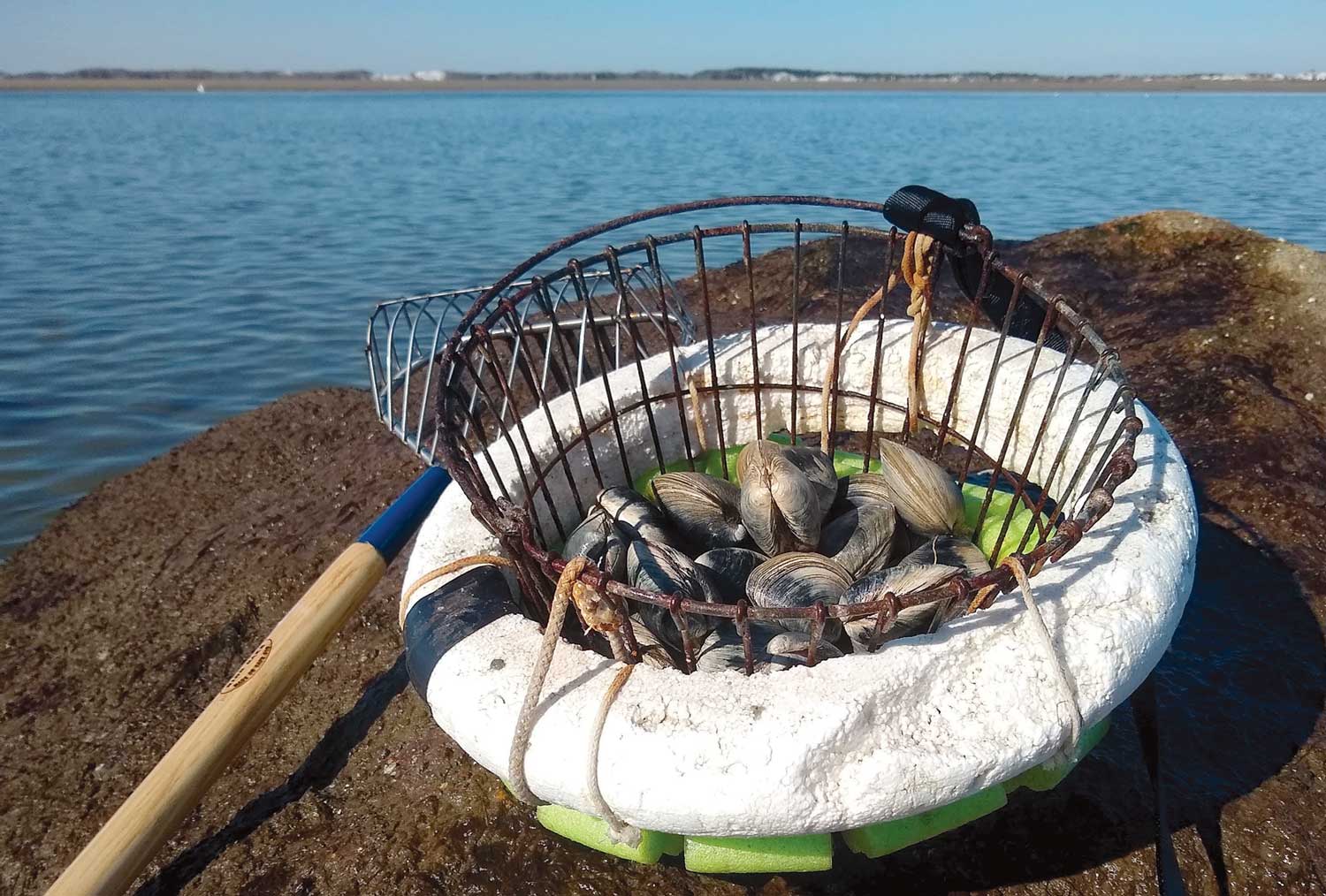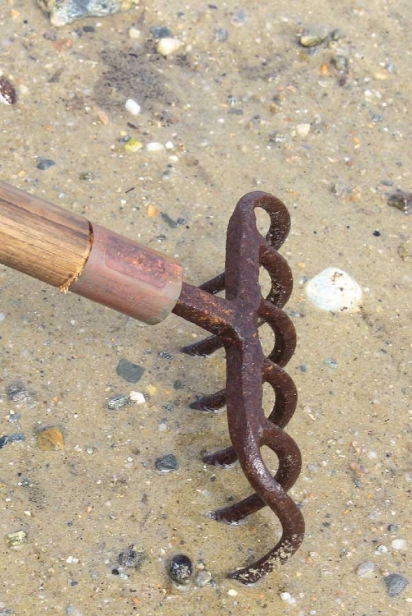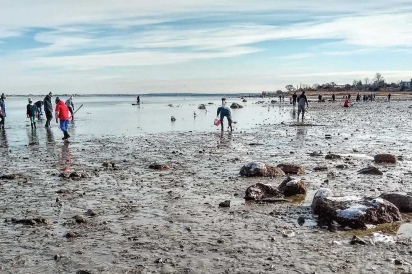Shellfishing Lure: Passing on a Love for Clamming One Quahog at a Time
Some things in life are worth passing down. One of them is a love for clamming, including a precious rake, where the favorite spots are, or even the best ways to eat them.
When treasured family memories are kept alive through things like a favorite rock or a rake, the tradition borders on the sacred. When you’re clamming in the same place you used to go with your dad, long after he’s gone, it almost feels like you might catch a glimpse of him out there on the horizon as the memories come flooding back while digging around.
A day on the water clamming always begins with a good story, too, especially when the family tradition spans more than half a century and is passed down from one generation to the next.
Sara Pratt, friend and server at Chapoqouit Grill in West Falmouth, remembers going clamming with her dad and grandfather as a kid to Fiddlers Cove in North Falmouth and over to the Tidal Flats in Bourne. She remembers how obsessed she was to go when the others decided to stay put and how much fun she had. Her grandfather used to pretend he was the warden. The warden is the one responsible for making sure people follow the rules and oversees where land meets the sea. Shellfishing is one of those perfect activities for families to enjoy together: You’re outdoors, there’s good bonding time, and if you are successful, you have gathered food for supper.
Those who shellfish can be categorized into different types. There are those who shellfish commercially and those who do it for fun and hobby. There are the new ones who finally go ahead and get a license of their own (like me, I got my first shellfishing license in 2021). Then there are the curious ones who pay close attention to the clusters of people out in low tide who are in their waders holding a rake and a basket. They are the ones always eager to taste what you’ve brought home but have yet to give it a try themselves.
Jane Baker, artist and art teacher at Falmouth High School, has been clamming since she was four when she used to go with her grandfather. Baker first went clamming in Stonington, CT and in Woods Hole, MA. She also went scalloping with her grandparents on Nantucket. Her dad’s parents had a house on the water in Stonington and her mom’s parents lived near the water on Nantucket. Baker grew up spending time in all three places for all of her childhood, and there was plenty of exploring to do in each. Baker’s grandfather had a big old wooden work boat at his dock — and the great treat for all of the grandchildren was when he’d take them out clamming in the bay. It got really shallow in a few places where he knew to go, and he had these big scissoring rake tongs that he’d open wide and jam down into the silt. Then they would shimmy the posts together and haul it up to the boat and dig through all the muck and seaworms and loose crabs. For Baker, shellfishing has been a part of her life for as long as she can remember. Her parents and grandparents taught her, and she has since passed her love for the pastime down to her children.
Albert Brox, a long-time recreational shellfisherman and Captain of the M/V Iyanough first went clamming around the age of seven with his dad. He remembers his dad used to always ask, “When is low tide?” as soon as he arrived on the Cape each Saturday. Low tide is the best time to look for clams, and they can be found in bays and estuaries that get plenty of tidal flow. Clams live in a variety of conditions, including sand, mud, and even rocky areas, though locations that feature more of a muddy/sandy bottom are best.
“I can still see him getting his gear on, watching him out in the water raking and then returning with a basket of quahogs” said Brox. The bigger ones they would stuff and bake. The smaller ones they’d eat right off the shell. His mom would help prepare them and his dad would talk about how proud he was of his catch. Neighborhood friends would come over to share in the bounty.
The first time Brox went with his dad he admits he didn’t initially see the appeal that his dad and friends saw in it because it turned out to be lots of work. The water would be warm and rather than swimming or messing around, they’d be raking and looking to fill a basket. His dad continued to go as soon as the tide was right and, as time passed, Brox went to spend time with his dad more than anything, to talk and enjoy the scenery together. At first, they went right in front of their house on the south side of the town of Barnstable. But as the years passed, they went to the north side because over there the quahogs seemed more plentiful. The north side is where Brox continues to go clamming today years after losing his father and brother. He turns his basket out to look at his catch and check for size and quality onto the same rock he went to with his father for all those years. He uses the same rake, too. It’s an old six-tine quahog rake, well used and not as pretty as the newer stainless-steel ones. He’s had to repair it over the years to keep using it. Since it was his dad’s, he can’t help but think of him when he uses it.
Baker says her husband has tried to get her, for the twenty years they’ve been together, to call all clams quahogs. She says in Connecticut all clams are referred to as clams and that specifically steamers are soft shell clams. To Baker, quahogs are the big hard-shell ones. Baker’s husband Stew was born and raised in Woods Hole and insists that clams are just steamers, and all hard shells are quahogs. She says he can be very stubborn about it at times and will appease him by saying she’s going “quahogging”.
Baker went to what’s known as Science School in the summers in Woods Hole for most of her youth. She took classes like Marine Biology, where she made longtime friends from around the country who would come to Woods Hole in the summer. They dug quahogs, dissected them, learned their anatomy and made chowder for the school’s open house. And by the time she was a teenager they were messing around in boats all over Great Harbor and the Islands. Initially she only went clamming with rakes but by this point she learned how to dig them with her bare feet. She says you have to “lean back with your heel, twist it a bit and feel around for lumps.” The mud is typically blackish, and it helps to be near but not in the eel grass. She admits she can spend most of a low tide digging around for clams this way because it’s weirdly relaxing.
Baker loved how as a kid on Nantucket, she dug up steamers in the creek, but admits the big game over there was scooping up scallops at low tide with her dad. Back then the kids didn’t know what they were doing and most of the time just threw them back, but it was fun to collect them and stare at their little eyes along the rim of the shell as they peered out when they opened slowly and then snapped shut.
For Brox, the fall season was when scallops were harvested, and his dad made a couple of viewers of his own to help find them on the ocean bottom. Viewers are plywood boxes with a piece of plexiglass that float on the surface allowing you look at the ocean bottom in the eel grass for scallops. Scallops have become less plentiful as the years have gone by, but back then everyone tried looking for scallops because it seemed different from quahogging with less raking on the bottom, too.
These days, Baker collects the clams in a mesh bag and carries them back to the official basket on the boat. Both of her kids have gone clamming with her as they were growing up. When they were younger, they would tag along and try to find some too. They’d get bored easily and either jump off the bow, snorkel for fish or go off to some other adventure. She passed on the tradition as if a life of clamming is as an essential or ordinary part of growing up as going off to school. Her earliest memory of clamming with her kids was when she went with her youngest carrying him in a baby sling at about one month old. She admits some of her favorite spots are secret. But one place she loves to go is with her kids and friends over to Washburn Island. They’d go a couple of times a year, camp and dig for quahogs.
Brox admits his favorite time to go clamming is on a beautiful fall day with a spring tide at maximum range, with a light wind. The oysters are an amazing size, flavor and hard to equal at any restaurant. He says he rarely orders them because they don’t seem to compare to when he sources them himself. These days he mostly goes alone but hopes his kids will join him more often so he can pass the torch and keep the family tradition going.
Pratt says many people have gotten more and more territorial over the years about where people can tool around in the water near their property line. But Pratt knows firsthand how special this tradition is and says they should let the kids come to give it a try. Clamming is as much a part of Cape Cod as a day at the beach or crossing the bridge.








